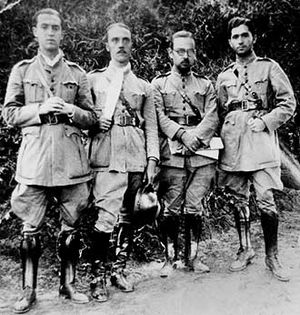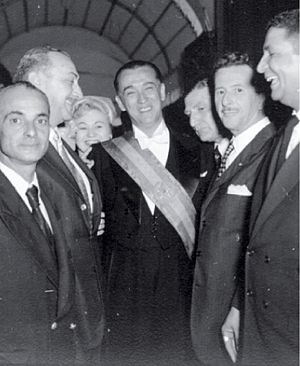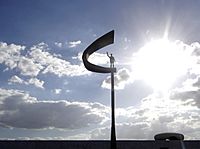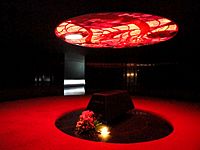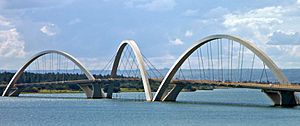Juscelino Kubitschek facts for kids
Quick facts for kids
Juscelino Kubitschek
|
|
|---|---|

Kubitschek in 1956
|
|
| President of Brazil | |
| In office 31 January 1956 – 30 January 1961 |
|
| Vice President | João Goulart |
| Preceded by | Nereu Ramos (interim) |
| Succeeded by | Jânio Quadros |
| Senator for Goiás | |
| In office 4 October 1961 – 8 June 1964 |
|
| Preceded by | Taciano Gomes de Melo |
| Succeeded by | João Abraão Sobrinho |
| Governor of Minas Gerais | |
| In office 31 January 1951 – 31 March 1955 |
|
| Vice Governor | Clóvis Salgado |
| Preceded by | Milton Campos |
| Succeeded by | Clóvis Salgado |
| Member of the Chamber of Deputies | |
| In office 5 February 1946 – 31 January 1951 |
|
| Constituency | Minas Gerais |
| In office 2 May 1935 – 10 November 1937 |
|
| Constituency | Minas Gerais |
| Mayor of Belo Horizonte | |
| In office 23 October 1940 – 30 October 1945 |
|
| Nominated by | Benedito Valadares |
| Preceded by | José de Araújo |
| Succeeded by | João Gusmán |
| Personal details | |
| Born |
Juscelino Kubitschek de Oliveira
12 September 1902 Diamantina, Minas Gerais, Brazil |
| Died | 22 August 1976 (aged 73) Resende, Rio de Janeiro, Brazil |
| Cause of death | Car accident |
| Resting place | JK Memorial |
| Political party | PP (1934–1937) PSD (1945–1965) |
| Spouse |
Sarah Gomes de Lemos
(m. 1931) |
| Children | 2 |
| Parents |
|
| Alma mater | Federal University of Minas Gerais School of Medicine |
| Profession |
|
| Signature | |
| Military service | |
| Allegiance | Brazil Minas Gerais |
| Branch/service | Brazilian Army Military Police of Minas Gerais |
| Years of service | 1931–1933 1937–1940 |
| Rank | Lieutenant colonel |
| Battles/wars | Constitutionalist Revolution |
Juscelino Kubitschek de Oliveira (born September 12, 1902 – died August 22, 1976), often called JK, was an important Brazilian politician. He served as the 21st President of Brazil from 1956 to 1961. His time as president was known for good economic growth and a stable government. He is most famous for building Brazil's new capital city, Brasília.
Contents
Early Life and Career
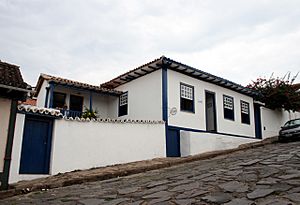
Juscelino Kubitschek was born into a poor family in Diamantina, Minas Gerais. His father passed away when Juscelino was only two years old. His mother, Júlia Kubitschek, was a schoolteacher and raised him.
He went to a seminary school in Diamantina. Later, when he was twenty, he studied at the Federal University of Minas Gerais in Belo Horizonte. After seven years, he became a licensed medical doctor.
After graduating, he lived in Europe for a few months. He returned to Brazil after the 1930 revolution, which brought Getúlio Vargas to power.
Kubitschek worked as a doctor in the military police. He also treated patients at a military hospital in Minas Gerais. He became friends with Benedito Valadares, who was the Governor of Minas Gerais. In 1932, the Governor made Kubitschek his Chief of Staff.
In 1934, Kubitschek ran for office for the first time. He became a member of the Federal Chamber of Deputies of Brazil. In 1940, he was chosen to be the Mayor of Belo Horizonte. He was known for wanting to build many public works and improve the city.
As Mayor, he worked closely with the famous architect Oscar Niemeyer. Kubitschek asked Niemeyer to design several buildings in Belo Horizonte. Niemeyer would later be very important in designing Brasília.
In 1945, he was elected to the Federal Chamber of Deputies again. In 1950, he ran for Governor of Minas Gerais and won. As Governor, he focused on improving transportation and energy. He created a government energy company that built five new power plants. He also worked to improve roads, bridges, schools, and hospitals.
Presidency
After President Getúlio Vargas died in 1954, new elections were held in 1955. Juscelino Kubitschek decided to run for president. His campaign slogan was "fifty years progress in five."
He promised to improve energy, farming, industry, education, and transportation. He also wanted to make Brazil's economy more diverse. He strongly supported moving the capital from Rio de Janeiro to a central location. This would help develop other parts of the country.
Before Kubitschek became president, some people worried about his ties to Vargas. There were even rumors of a military takeover. But Henrique Teixeira Lott, the Minister of War, and other military leaders acted. They made sure that Juscelino Kubitschek became president. He was sworn in as the 21st President of Brazil on January 31, 1956.
His economic plan had 31 goals. These goals were grouped into six main areas: energy, transport, food, basic industries, education, and building Brasília. This plan aimed to grow Brazil's economy. It focused on expanding industries and connecting the country better.
Healthcare Initiatives
As a doctor, Juscelino cared a lot about healthcare. He promised to create a central health office. This office would help with health problems in rural areas.
One important agency was DNERU. It was created to fight diseases like tuberculosis and malaria. It also gave vaccines in areas where healthcare was hard to reach.
Economy and Major Works

Kubitschek's main goal was to develop Brazil's industries. His "Goals Plan," started in 1956, opened Brazil's economy to foreign investments. He removed taxes on imported machines and industrial equipment. This helped foreign companies invest in Brazil.
He encouraged the growth of the car industry, shipbuilding, and heavy industries. He also built hydroelectric power stations. He focused a lot on building roads across different regions. Some people criticized him for focusing only on roads and not railways.
The new roads helped connect the Amazon region. They also helped with the building of Brasília. In the short term, Brazil's economy grew quickly under his leadership. Industrial production increased by 80% by the end of his term.
The minimum wage during his presidency was the highest in Brazilian history. However, the country's foreign debt also grew. Inflation, which is when prices go up, also increased.
Building Brasília
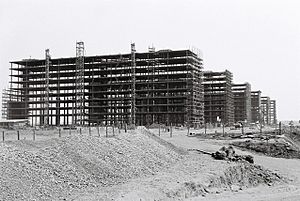
The idea of building a new capital in the center of Brazil was not new. It was mentioned in earlier Brazilian constitutions. But it was Kubitschek's promise to develop the country's interior that made it happen.
Moving the capital from Rio de Janeiro was a big debate at first. Many people had different opinions. But planning for the new city began in 1956.
The work started in February 1957. It was led by urban planner Lucio Costa, architect Oscar Niemeyer, and landscape designer Roberto Burle Marx. More than 200 machines and 30,000 workers came from all over Brazil. They worked day and night to finish Brasília by April 21, 1960. This date honored a historical event and the founding of Rome.
A completely new city, with streets, government buildings, and homes, appeared in the middle of a savanna. It was built in just 41 months. When it opened, Brasília was seen as a masterpiece of city planning and modern architecture.
Brasília helped connect Brazil's far-off regions. It brought development to unpopulated areas. It also created many jobs and helped the economy of the Central-West and North regions.
Addressing Concerns
Kubitschek's government faced some accusations of corruption. These claims started when he was governor and grew during his presidency. They were mostly related to the building of Brasília. Some believed that people close to him received special favors.
There were also claims about his wealth. However, after his death, it was shown that he had very little money. This proved the accusations were not true. Later, during the military government, he was questioned about these claims. He was also asked about supposed ties to communist groups.
Kubitschek was followed by Jânio Quadros as president in 1961. After the military took power in 1964, Kubitschek's political rights were taken away for 10 years. He chose to live outside Brazil for a while, staying in cities in the U.S. and Europe.
Return to Brazil and Death
Kubitschek came back to Brazil in 1967. He died in a car crash in 1976, near the city of Resende in Rio de Janeiro. About 350,000 people attended his burial in Brasília. He is now buried in the JK Memorial in Brasília, which opened in 1981.
Honours
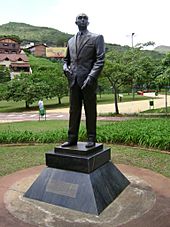
Many places and things are named after Juscelino Kubitschek. These include the Brasília International Airport, the Juscelino Kubitschek bridge, and the Juscelino Kubitschek Power Plant. There is also a luxury hotel in Brasília called Kubitschek Plaza.
Many cities have things named after him, like Juscelino Kubitschek, Santa Maria. "JK" is a common nickname honoring him. Many Brazilians see him as the "father of modern Brazil."
Foreign Honours
 Collar of the Order of the Aztec Eagle
Collar of the Order of the Aztec Eagle Collar of the Order of Isabella the Catholic
Collar of the Order of Isabella the Catholic 1st Class of the Order of Tomáš Garrigue Masaryk (given after his death)
1st Class of the Order of Tomáš Garrigue Masaryk (given after his death) Grand Cross of the Order of Christ
Grand Cross of the Order of Christ Grand Cross Special Class of the Order of Merit of the Federal Republic of Germany
Grand Cross Special Class of the Order of Merit of the Federal Republic of Germany Honorary Knight Grand Cross of The Most Excellent Order of the British Empire
Honorary Knight Grand Cross of The Most Excellent Order of the British Empire
Media
In 2006, Globo created a miniseries about Kubitschek's life called JK. It starred Wagner Moura and José Wilker.
Descendants
In 1980, his daughter Márcia Kubitschek (1943–2000) married the Cuban-American ballet star Fernando Bujones. Márcia Kubitschek was elected to the National Congress of Brazil in 1987. She also served as lieutenant governor of the Federal District from 1991 to 1994.
See also
 In Spanish: Juscelino Kubitschek para niños
In Spanish: Juscelino Kubitschek para niños


